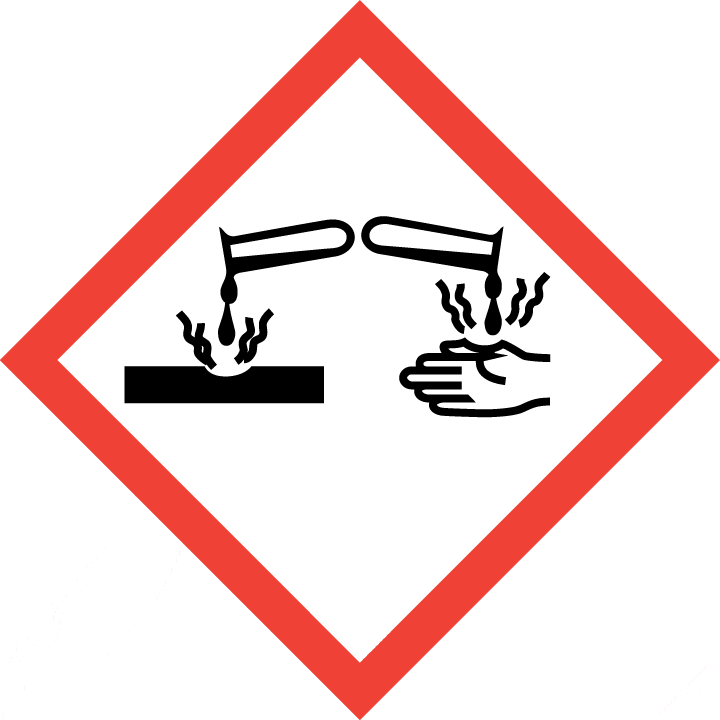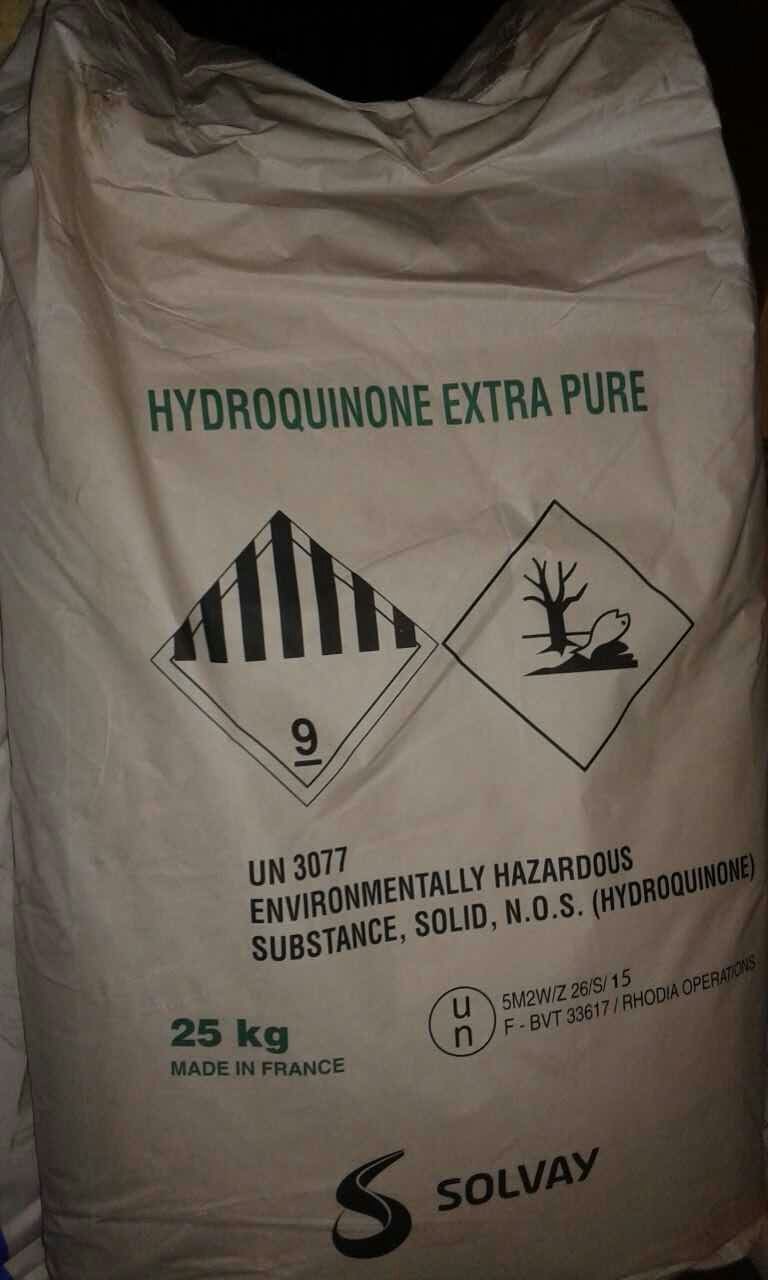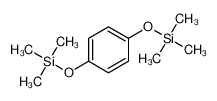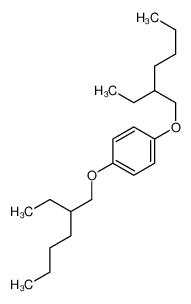| Product name | hydroquinone |
|---|
| Product number | - |
|---|---|
| Other names | 1,4-benzenediol |
| Identified uses | For industry use only. Hydroquinone is used as a developing agent in black-and-white photography, lithography, and x-ray films. It is also used as an intermediate to produce antioxidants for rubber and food. It is added to a number of industrial monomers to inhibit polymerization during shipping, storage, and processing. |
|---|---|
| Uses advised against | no data available |
| Company | MOLBASE (Shanghai) Biotechnology Co., Ltd. |
|---|---|
| Address | Floor 4 & 5, Building 12, No. 1001 North Qinzhou Road, Xuhui District, Shanghai, China |
| Telephone | +86(21)64956998 |
| Fax | +86(21)54365166 |
| Emergency phone number | +86-400-6021-666 |
|---|---|
| Service hours | Monday to Friday, 9am-5pm (Standard time zone: UTC/GMT +8 hours). |
Acute toxicity - Oral, Category 4
Serious eye damage, Category 1
Skin sensitization, Category 1
Germ cell mutagenicity, Category 2
Carcinogenicity, Category 2
Hazardous to the aquatic environment, short-term (Acute) - Category Acute 1
2.2 GHS label elements, including precautionary statements| Pictogram(s) |     |
|---|---|
| Signal word | Danger |
| Hazard statement(s) | H302 Harmful if swallowed H318 Causes serious eye damage H317 May cause an allergic skin reaction H341 Suspected of causing genetic defects H351 Suspected of causing cancer H400 Very toxic to aquatic life |
| Precautionary statement(s) | |
| Prevention | P264 Wash ... thoroughly after handling. P270 Do not eat, drink or smoke when using this product. P280 Wear protective gloves/protective clothing/eye protection/face protection. P261 Avoid breathing dust/fume/gas/mist/vapours/spray. P272 Contaminated work clothing should not be allowed out of the workplace. P201 Obtain special instructions before use. P202 Do not handle until all safety precautions have been read and understood. P273 Avoid release to the environment. |
| Response | P301+P312 IF SWALLOWED: Call a POISON CENTER/doctor/…if you feel unwell. P330 Rinse mouth. P305+P351+P338 IF IN EYES: Rinse cautiously with water for several minutes. Remove contact lenses, if present and easy to do. Continue rinsing. P310 Immediately call a POISON CENTER/doctor/… P302+P352 IF ON SKIN: Wash with plenty of water/... P333+P313 If skin irritation or rash occurs: Get medical advice/attention. P321 Specific treatment (see ... on this label). P362+P364 Take off contaminated clothing and wash it before reuse. P308+P313 IF exposed or concerned: Get medical advice/ attention. P391 Collect spillage. |
| Storage | P405 Store locked up. |
| Disposal | P501 Dispose of contents/container to ... |
none
3.Composition/information on ingredients 3.1 Substances| Chemical name | Common names and synonyms | CAS number | EC number | Concentration |
|---|---|---|---|---|
| hydroquinone | hydroquinone | 123-31-9 | none | 100% |
Consult a physician. Show this safety data sheet to the doctor in attendance.
If inhaledFresh air, rest. Artificial respiration may be needed. Refer for medical attention.
In case of skin contactRemove contaminated clothes. Rinse and then wash skin with water and soap.
In case of eye contactFirst rinse with plenty of water for several minutes (remove contact lenses if easily possible), then refer for medical attention.
If swallowedRinse mouth. Induce vomiting (ONLY IN CONSCIOUS PERSONS!). Refer for medical attention .
4.2 Most important symptoms/effects, acute and delayedThis material is very toxic; the probable oral lethal dose for humans is 50-500 mg/kg, or between 1 teaspoon and 1 ounce for a 150 lb. person. It is irritating but not corrosive. Fatal human doses have ranged from 5-12 grams, but 300-500 mg have been ingested daily for 3-5 months without ill effects. Death is apparently initiated by respiratory failure or anoxia. (EPA, 1998)
4.3 Indication of immediate medical attention and special treatment needed, if necessary/SRP:/ Immediate first aid: Ensure that adequate decontamination has been carried out. If patient is not breathing, start artificial respiration, preferably with a demand-valve resuscitator, bag-valve-mask device, or pocket mask, as trained. Perform CPR as necessary. Immediately flush contaminated eyes with gently flowing water. Do not induce vomiting. If vomiting occurs, lean patient forward or place on left side (head-down position, if possible) to maintain an open airway and prevent aspiration. Keep patient quiet and maintain normal body temperature. Obtain medical attention. /Aniline and related compounds/
5.Fire-fighting measures 5.1 Extinguishing media Suitable extinguishing mediaTo fight fire, use water, carbon dioxide, dry chem ... .
5.2 Specific hazards arising from the chemicalDust cloud may explode if ignited in an enclosed area. It can react with oxidizing materials and is rapidly oxidized in the presence of alkaline materials. Oxidizes in air. (EPA, 1998)
5.3 Special protective actions for fire-fightersWear self-contained breathing apparatus for firefighting if necessary.
6.Accidental release measures 6.1 Personal precautions, protective equipment and emergency proceduresUse personal protective equipment. Avoid dust formation. Avoid breathing vapours, mist or gas. Ensure adequate ventilation. Evacuate personnel to safe areas. Avoid breathing dust. For personal protection see section 8.
6.2 Environmental precautionsPersonal protection: particulate filter respirator adapted to the airborne concentration of the substance. Do NOT let this chemical enter the environment. Sweep spilled substance into covered sealable containers. Carefully collect remainder. Then store and dispose of according to local regulations.
6.3 Methods and materials for containment and cleaning upEnvironmental Considerations: Land spill: Dig a pit, pond, lagoon, holding area to contain liquid or solid material. Cover solids with a plastic sheet to prevent dissolving in rain or fire fighting water. Dike surface flow using soil, sand bags, foamed polyurethane, or foamed concrete. Absorb bulk liquid with fly ash, cement powder, or commercial sorbents. /SRP: If time permits, pits, ponds, lagoons, soak holes, or holding areas should be sealed with an impermeable flexible membrane liner./
7.Handling and storage 7.1 Precautions for safe handlingAvoid contact with skin and eyes. Avoid formation of dust and aerosols. Avoid exposure - obtain special instructions before use.Provide appropriate exhaust ventilation at places where dust is formed. For precautions see section 2.2.
7.2 Conditions for safe storage, including any incompatibilitiesSeparated from strong bases and food and feedstuffs.Keep well closed and protected from light.
8.Exposure controls/personal protection 8.1 Control parameters Occupational Exposure limit valuesRecommended Exposure Limit: 15 Min Ceiling Value: 2 mg/cu m.
Biological limit valuesno data available
8.2 Appropriate engineering controlsHandle in accordance with good industrial hygiene and safety practice. Wash hands before breaks and at the end of workday.
8.3 Individual protection measures, such as personal protective equipment (PPE) Eye/face protectionSafety glasses with side-shields conforming to EN166. Use equipment for eye protection tested and approved under appropriate government standards such as NIOSH (US) or EN 166(EU).
Skin protectionWear impervious clothing. The type of protective equipment must be selected according to the concentration and amount of the dangerous substance at the specific workplace. Handle with gloves. Gloves must be inspected prior to use. Use proper glove removal technique(without touching glove's outer surface) to avoid skin contact with this product. Dispose of contaminated gloves after use in accordance with applicable laws and good laboratory practices. Wash and dry hands. The selected protective gloves have to satisfy the specifications of EU Directive 89/686/EEC and the standard EN 374 derived from it.
Respiratory protectionWear dust mask when handling large quantities.
Thermal hazardsno data available
9.Physical and chemical properties| Physical state | off-white powder or white needle-like crystals |
|---|---|
| Colour | White crystals |
| Odour | Odorless |
| Melting point/ freezing point | 2°C(lit.) |
| Boiling point or initial boiling point and boiling range | 285°C(lit.) |
| Flammability | Combustible Solid; dust cloud may explode if ignited in an enclosed area.Combustible. |
| Lower and upper explosion limit / flammability limit | no data available |
| Flash point | 165°C |
| Auto-ignition temperature | 498.89°C |
| Decomposition temperature | no data available |
| pH | no data available |
| Kinematic viscosity | no data available |
| Solubility | In water:70 g/L (20 ºC) |
| Partition coefficient n-octanol/water (log value) | no data available |
| Vapour pressure | 1 mm Hg ( 132 °C) |
| Density and/or relative density | 1.332 |
| Relative vapour density | 3.81 (vs air) |
| Particle characteristics | no data available |
no data available
10.2 Chemical stabilityIts solution becomes brown in air due to oxidation.
10.3 Possibility of hazardous reactionsFire hazard: slight, when exposed to heat or flame; can react with oxidizing materials.Dust explosion possible if in powder or granular form, mixed with air.HYDROQUINONE is a slight explosion hazard when exposed to heat. Incompatible with strong oxidizing agents. Also incompatible with bases. It reacts with oxygen and sodium hydroxide. Reacts with ferric salts . Hot and/or concentrated NaOH can cause hydroquinone to decompose exothermically at elevated temperature. (NFPA Pub. 491M, 1975, 385)
10.4 Conditions to avoidno data available
10.5 Incompatible materialsStrong oxidizers, alkalis.
10.6 Hazardous decomposition productsno data available
11.Toxicological information Acute toxicity- Oral: LD50 Rat oral 320 mg/kg
- Inhalation: no data available
- Dermal: no data available
no data available
Serious eye damage/irritationno data available
Respiratory or skin sensitizationno data available
Germ cell mutagenicityno data available
CarcinogenicityEvaluation: There is inadequate evidence in humans for the carcinogenicity of hydroquinone. There is limited evidence in experimental animals for the carcinogenicity of hydroquinone. Overall evaluation: Hydroquinone is not classifiable as to its carcinogenicity to humans (Group 3).
Reproductive toxicityNo information is available on the reproductive or developmental effects of hydroquinone in humans. A slight reduction in maternal body weight gain, decreased fetal weight, increased resorption rate, and reduced fertility in males have been observed in rats orally exposed to hydroquinone via gavage or in the diet. Exposure of rabbits to hydroquinone via gavage produced negligible developmental alterations.
STOT-single exposureno data available
STOT-repeated exposureno data available
Aspiration hazardno data available
12.Ecological information 12.1 Toxicity- Toxicity to fish: LC50; Species: Danio rerio (Zebra danio) length 2.5 cm; Conditions: freshwater, static, 22°C, pH 7-7.8, hardness 150 mg/L CaCO3; Concentration: <1000 ug/L for 24 hr
- Toxicity to daphnia and other aquatic invertebrates: EC50; Species: Daphnia magna (Water flea) age 6-24 hr; Conditions: freshwater, static, 20°C, pH > or =7.0; Concentration: 320 ug/L for 24 hr (95% confidence interval: 270-380 ug/L); Effect: intoxication, immobilization /formulation
- Toxicity to algae: no data available
- Toxicity to microorganisms: no data available
AEROBIC: Hydroquinone at a concentration of 0.05 mg/L underwent 7.5% removal in 5 days when inoculated with an activated sludge seed(1,2). Sewage sludge activated to phenol was found to oxidize hydroquinone(3,4). Pure culture oxidation of hydroquinone produced 1,4-benzoquinone, 2-hydroxy-1,4-benzoquinone and beta-ketoadipic acid(5). In a screening study using a sewage seed, hydroquinone had a 5 day theoretical BOD of 25.3%(6). Hydroquinone at an initial concentration of 200 mg/L COD underwent 54.2% removal (less than 120 hours) using a thickened adapted activated sludge under aerobic conditions(7). Activated sludges adapted to aniline, phenol or m-cresol were found to biodegrade hydroquinone under aerobic conditions(8). It was listed as undergoing rapid biodegradation in a commercial activated sludge unit under aerobic conditions(9).
12.3 Bioaccumulative potentialAn estimated BCF of 3 was calculated in fish for hydroquinone(SRC), using a log Kow of 0.59(1) and a regression-derived equation(2). According to a classification scheme(3), this BCF suggests the potential for bioconcentration in aquatic organisms is low(SRC). A bioaccumulation factor of 40 was measured using Golden ide fish (Leuciscus idus melanotus) exposed for 3 days to 0.05 mg/L hydroquinone(4,5). Experimental 24-hour bioaccumulation factors in alga were 40 and 65 for hydroquinone(4-6).
12.4 Mobility in soilUsing a structure estimation method based on molecular connectivity indices(1), the Koc of hydroquinone is estimated as 240(SRC). According to a classification scheme(2), this estimated Koc value suggests that hydroquinone is expected to have moderate mobility in soil. Hydroquinone can exhibit chemisorption to transition metal-containing particulate matter via reaction with the copper oxide/silca surfaces present(3).
12.5 Other adverse effectsno data available
13.Disposal considerations 13.1 Disposal methods ProductThe material can be disposed of by removal to a licensed chemical destruction plant or by controlled incineration with flue gas scrubbing. Do not contaminate water, foodstuffs, feed or seed by storage or disposal. Do not discharge to sewer systems.
Contaminated packagingContainers can be triply rinsed (or equivalent) and offered for recycling or reconditioning. Alternatively, the packaging can be punctured to make it unusable for other purposes and then be disposed of in a sanitary landfill. Controlled incineration with flue gas scrubbing is possible for combustible packaging materials.
14.Transport information 14.1 UN Number| ADR/RID: UN3077 | IMDG: UN3077 | IATA: UN3077 |
| ADR/RID: ENVIRONMENTALLY HAZARDOUS SUBSTANCE, SOLID, N.O.S. |
| IMDG: ENVIRONMENTALLY HAZARDOUS SUBSTANCE, SOLID, N.O.S. |
| IATA: ENVIRONMENTALLY HAZARDOUS SUBSTANCE, SOLID, N.O.S. |
| ADR/RID: 9 | IMDG: 9 | IATA: 9 |
| ADR/RID: III | IMDG: III | IATA: III |
| ADR/RID: yes | IMDG: yes | IATA: yes |
no data available
14.7 Transport in bulk according to Annex II of MARPOL 73/78 and the IBC Codeno data available
15.Regulatory information 15.1 Safety, health and environmental regulations specific for the product in question| Chemical name | Common names and synonyms | CAS number | EC number |
|---|---|---|---|
| hydroquinone | hydroquinone | 123-31-9 | none |
| European Inventory of Existing Commercial Chemical Substances (EINECS) | Listed. | ||
| EC Inventory | Listed. | ||
| United States Toxic Substances Control Act (TSCA) Inventory | Listed. | ||
| China Catalog of Hazardous chemicals 2015 | Listed. | ||
| New Zealand Inventory of Chemicals (NZIoC) | Listed. | ||
| Philippines Inventory of Chemicals and Chemical Substances (PICCS) | Listed. | ||
| Vietnam National Chemical Inventory | Listed. | ||
| Chinese Chemical Inventory of Existing Chemical Substances (China IECSC) | Listed. | ||
| Creation Date | Aug 10, 2017 |
|---|---|
| Revision Date | Aug 10, 2017 |
- CAS: Chemical Abstracts Service
- ADR: European Agreement concerning the International Carriage of Dangerous Goods by Road
- RID: Regulation concerning the International Carriage of Dangerous Goods by Rail
- IMDG: International Maritime Dangerous Goods
- IATA: International Air Transportation Association
- TWA: Time Weighted Average
- STEL: Short term exposure limit
- LC50: Lethal Concentration 50%
- LD50: Lethal Dose 50%
- EC50: Effective Concentration 50%
- IPCS - The International Chemical Safety Cards (ICSC), website: http://www.ilo.org/dyn/icsc/showcard.home
- HSDB - Hazardous Substances Data Bank, website: https://toxnet.nlm.nih.gov/newtoxnet/hsdb.htm
- IARC - International Agency for Research on Cancer, website: http://www.iarc.fr/
- eChemPortal - The Global Portal to Information on Chemical Substances by OECD, website: http://www.echemportal.org/echemportal/index?pageID=0&request_locale=en
- CAMEO Chemicals, website: http://cameochemicals.noaa.gov/search/simple
- ChemIDplus, website: http://chem.sis.nlm.nih.gov/chemidplus/chemidlite.jsp
- ERG - Emergency Response Guidebook by U.S. Department of Transportation, website: http://www.phmsa.dot.gov/hazmat/library/erg
- Germany GESTIS-database on hazard substance, website: http://www.dguv.de/ifa/gestis/gestis-stoffdatenbank/index-2.jsp
- ECHA - European Chemicals Agency, website: https://echa.europa.eu/

































